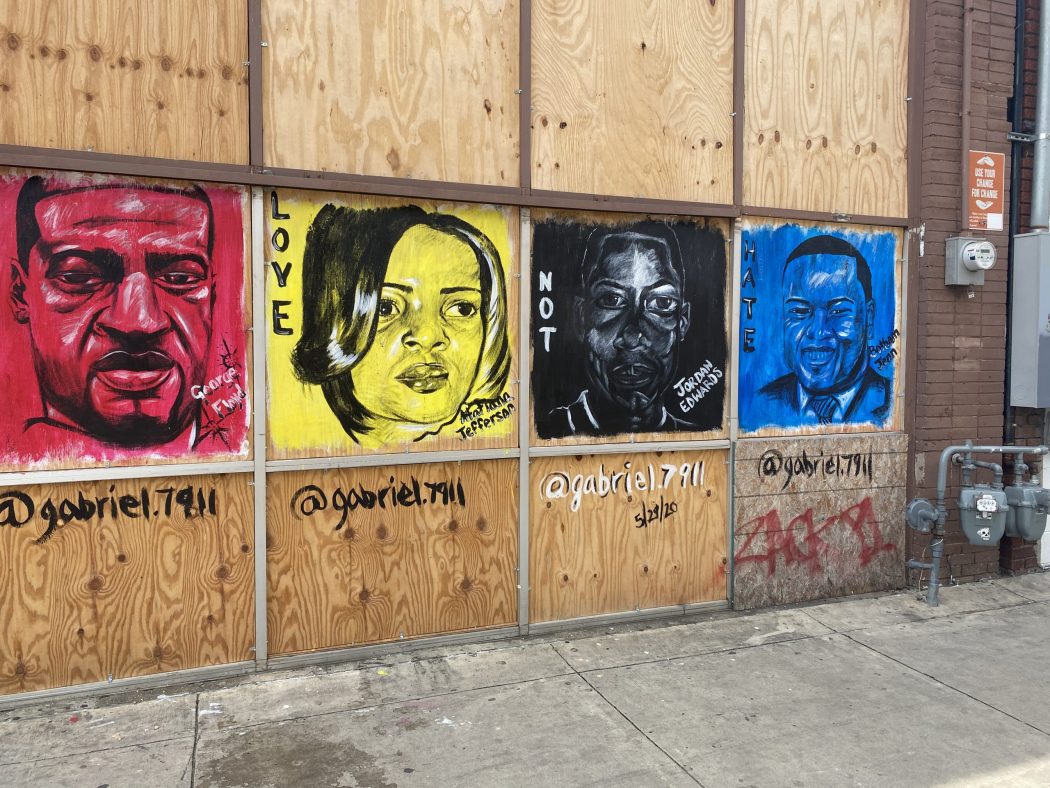
A mural of George Floyd, Atatiana Jefferson, Jordan Edwards and Botham Jean painted by Gabriel Thomas. Photography by Claire Crow
On a summer evening in Chicago in 1994, a group of us went to a bar after a co-ed softball game. As we were relishing our victory, one of the women blurted a horrifically racist opinion. My boyfriend at the time immediately grabbed my knee under the table, not because he was shocked by what he heard, but rather, he was silently begging me not to say anything.
Someone tried to change the subject, but the woman doubled down. To no one’s surprise, I did say something. I don’t remember my words, but I recall a heated exchange. I left the table that night feeling confident I had won the debate.
To this day, I’m happy I spoke up. As I reflect on that incident, the whole thing could have gone down differently. I could have opened a conversation with everyone to better understand their positions on race. Instead, I was angry and emotional as I lashed out. In the history of forever, few people modify their beliefs after being told they’re ignorant and wrong. If I moved the needle at all, it was in the opposite direction.
On our way home, my clearly annoyed boyfriend said, “You know, Mita, you can’t change the world.” I replied, “You’re right, but I can change the world around me.”
I passively terminated whatever relationship I had with the woman and eventually realized I couldn’t be with someone who did not feel compelled to do the same.
There’s a difference between being a non-racist and an anti-racist. I have been the former without knowing the difference. I believed it was enough to call someone out and remove them from my life. What a ridiculously vain position. You must want to be my friend. Racists need not apply.
Being an ally of the black community requires more than tolerance and acceptance. It’s beyond marching in protest, speaking up and calling out. A path to combatting systemic racism is to recognize, understand and work to reverse the systems that have created negative realities while admitting our own complicity in allowing these systems to continue.
It is incumbent on each of us to dive into our country’s history of black suppression to understand how we arrived where we are.
Modern-day Dallas was intentionally designed to be segregated. Slavery, Reconstruction, Jim Crow laws and redlining — a series of government-sanctioned policies designed to devalue black residents and their communities — have resulted in disparities in our predominantly black neighborhoods. The disparities include poor access to quality food, health care, housing, employment, transportation and educational opportunities.
If that wasn’t bad enough, throw in racial profiling and our present-day criminal justice system. We end up with disproportionately more black men in jail than any other subgroup for the same crimes.
We live in a city where in 1923, the State Fair of Texas hosted “Ku Klux Klan Day.” We reside in a part of town where, nearly a century after the Union was victorious in the Civil War, two of our neighborhood schools were named to honor Confederate generals.
History books were written to modify the narrative of the Civil War. Having grown up in Illinois, the Land of Lincoln, I learned that the war between the states was over slavery. My husband in Tomball was taught the Civil War was about “states’ rights.” We are a country, a state and a city with a legacy of overt racism. That legacy permeates the present because we have not owned up to and reconciled our past.
There has been progress and continued outrage, but there has been little change. James Byrd was dragged three miles from the back of a pickup truck in Jasper County in 1998. Sandra Bland was stopped in Waller County by police in 2015 for failing to signal correctly. She died three days later in a jail cell. Two years ago, Botham Jean had the audacity to get up from his couch when a stranger entered his apartment.
More recently, George Floyd died at the hands of public servants. Three white vigilantes felt justified in murdering Ahmaud Arbery. Police officers shot Breonna Taylor eight times while she was sleeping in her bed.
There is the additional crime of justice rarely being doled out equitably. A black man may spend 20 years in prison for a drug offense, but Amber Guyger, the woman who killed Botham Jean, is eligible for parole in five years.
Yet I feel a sliver of hope. This time, the protests feel different. It’s not enough, but I’m hoping it will ultimately make a difference.





